18. Sequences
c3. Bounded, Monotonic Sequence Theorem
Sometimes you want to show that a sequence has a limit even if you can't write down a simple formula for the limit. The following theorem can determine if the limit exists. The proof link goes to the proof which is at the end of this chapter after the precise definition of the limit of a sequence.
Every increasing sequence which is
bounded above is convergent
to the least upper bound.
Every decreasing sequence which is
bounded below is convergent
to the greatest lower bound.
Every bounded, monotonic sequence is
convergent.
Every unbounded, increasing sequence is
divergent to \(\infty\).
Every unbounded, decreasing sequence is
divergent to \(-\infty\).
If the sequence is increasing but bounded above, it can't "increase forever" and must approach some number below the known upper bound.
We will later apply the theorem to sequences for which it is not easy to compute the limit. For now we take a look at three sequences for which it is easy to check whether the sequence is bounded or monotonic and to compute the limit. We will also see the dangers of trusting a plot and not carefully checking the sequence is both bounded and monotonic.
Determine whether each sequence is bounded and/or monotonic and whether the theorem says the sequence is convergent or divergent to \(\pm\infty\).
-
\(a_n=\dfrac{n^2}{n^2+10}\)
Bounded above by \(1\) and increasing, and hence convergent.
\(\lim\limits_{n\to\infty}\dfrac{n^2}{n^2+10}=1\)Since \(n^2\lt n^2+10\), we have \(\dfrac{n^2}{n^2+10}\lt 1\), i.e. \(a_n\) is bounded above by \(1\).
First notice that \(a_n=\dfrac{n^2+10-10}{n^2+10}=1-\dfrac{10}{n^2+10}\).
Since \(0\lt n\lt n+1\), we have \(n^2 \lt (n+1)^2\) and \(n^2+10 \lt (n+1)^2+10\).
Then \(\dfrac{10}{n^2+10}\gt \dfrac{10}{(n+1)^2+10}\) and \(1-\dfrac{10}{n^2+10}\lt 1-\dfrac{10}{(n+1)^2+10}\).
So \(a_n\lt a_{n+1}\), i.e. the sequence is increasing and hence convergent.
In fact, we can compute \[ \lim_{n\to\infty}\dfrac{n^2}{n^2+10} =\lim_{n\to\infty}\dfrac{1}{1+\dfrac{10}{n^2}} =1 \]Here is the plot of the first \(10\) terms of the sequence. It appears that the limit is \(1\).
But to be "sure" here is the plot of the first \(100\) terms of the sequence.
However, there is no guarantee that even \(100\) terms is enough.
(See the next two exercises.)
Only a computation like the one in the solution can really show the limit is \(1\).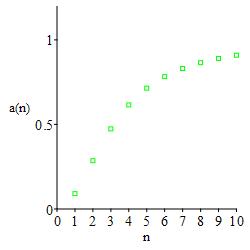
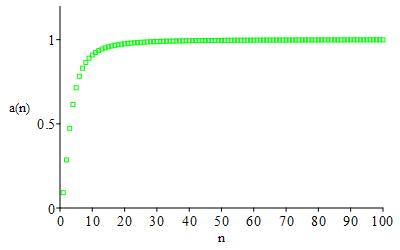
-
\(b_n=\dfrac{8n}{n^2+64}\)
Bounded below but not monotonic. So the theorem does not say it converges or diverges.
In fact it converges: \[ \lim_{n\to\infty}\dfrac{8n}{n^2+64}=0 \]Assuming \(n\ge 1\), all terms are positive and so the sequence is bounded below by \(0\).
Regard \(n\) as a continuous variable and take the derivative: \[ \dfrac{d(b_n)}{dn}=\dfrac{(n^2+64)8-8n(2n)}{(n^2+64)^2} =\dfrac{512-8n^2}{(n^2+64)^2} \] This is positive for \(n\le 8\) and negative for \(n\ge 8\).
So the sequence is increasing for \(n\le 8\) and decreasing for \(n\ge 8\).
Since the sequence is not monotonic, the theorem does not directly say whether the sequence converges or diverges. However, if we start the index of the sequence at \(n=8\), then the sequence is decreasing and the theorem says it is convergent. So the original sequence is also convergent since convergence does not care about the behavior of any finite number of terms, only the tail of the sequence.
In fact, we can compute \[ \lim_{n\to\infty}\dfrac{8n}{n^2+64} =\lim_{n\to\infty}\dfrac{\dfrac{8}{n}}{1+\dfrac{64}{n^2}} =0 \]Here is the plot of the first \(10\) terms of the sequence. It appears that the limit is \(\dfrac{1}{2}\).
But to be "sure" here is the plot of the first \(100\) terms of the sequence.
Oops. It now appears that the limit may be \(0\).
However, only a computation like the one in the solution can really show the limit is \(0\).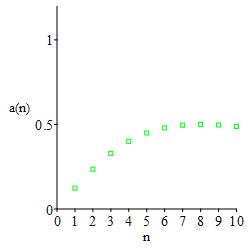
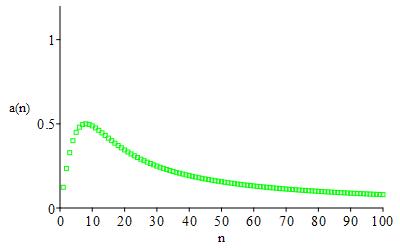
-
\(c_n=\dfrac{n^{2.1}}{2n^2+1}\)
Increasing and unbounded, and hence divergent to \(\infty\).
\(\lim\limits_{n\to\infty}\dfrac{n^{2.1}}{2n^2+1}=\infty\)Regard \(n\) as a continuous variable and take the derivative: \[ \dfrac{d(c_n)}{dn}=\dfrac{(2n^2+1)2.1n^{1.1}-n^{2.1}4n}{(2n^2+1)^2} =\dfrac{.2n^{3.1}+2.1n^{1.1}}{(2n^2+1)^2} \] Since this is always positive, the sequence is increasing.
Now notice that \(c_n=\dfrac{n^{.1}}{2+\dfrac{1}{n^2}}\). The numerator can be arbitrarily large and the denominator stays between \(2\) and \(3\). So we expect the sequence is unbounded.
To see this we use a proof by contradiction. Suppose there is an upper bound \(M\). Then for all \(n\) we know: \[ \dfrac{n^{.1}}{2+\dfrac{1}{n^2}}\le M \] We multiply both sides by the denominator: \[ n^{.1}\le M\left(2+\dfrac{1}{n^2}\right) \] Now since \(n\ge 1\) we know \(2+\dfrac{1}{n^2}\le 3\), and so: \[ n^{.1}\le 3M \] for all \(n\). However, if \(n \gt (3M)^{10}\), this will be false! This is a contradiction. So there is no upper bound.Here is the plot of the first \(10\) terms of the sequence. It appears that the limit may be about \(\dfrac{2}{3}\).
But to be "sure" here is the plot of the first \(100\) terms of the sequence.
Oops. It now appears that the limit may be somewhat bigger, maybe \(\dfrac{3}{4}\) or maybe \(1\).
However, the computation in the solution shows the limit is actually \(\infty\) although the series grows extremely slowly.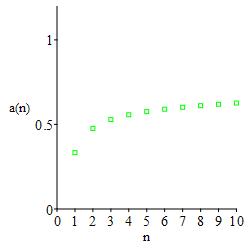
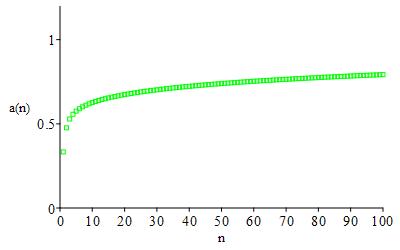
As you can see from the discussion of the plots in the three examples, it is very dangerous to trust a plot (or the numerical values of any number of terms) to estimate the limit of a sequence.
Heading
Placeholder text: Lorem ipsum Lorem ipsum Lorem ipsum Lorem ipsum Lorem ipsum Lorem ipsum Lorem ipsum Lorem ipsum Lorem ipsum Lorem ipsum Lorem ipsum Lorem ipsum Lorem ipsum Lorem ipsum Lorem ipsum Lorem ipsum Lorem ipsum Lorem ipsum Lorem ipsum Lorem ipsum Lorem ipsum Lorem ipsum Lorem ipsum Lorem ipsum Lorem ipsum